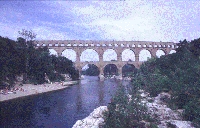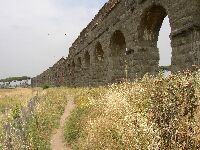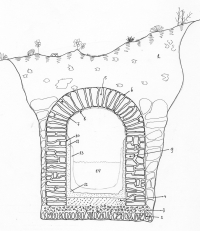


- trench
- foundation
- footing
- floor
- vault
- extrados
- intrados, soffit
- imprint of the formwork
- side wall
- plaster
- coating of opus signinum
- quaterround
- concretion, sinter
- aqueduct water
Aqueducts
An aqueduct is a channel or pipeline to conduct a water flow over a great distance from its source to its main distribution point. In some languages the word aqueduct (or aquaduct) stands for a bridge, other people associate aqueducts with a long row of arches as present just outside Rome, see illustrations above. Here a channel or pipeline is meant.Construction
The water flowed to its distribution point - often near a city or urban 'villa' - by the force of gravity alone and preferrably with a constant gradient. Some 80% of the aqueduct course was subterranean, often built in a trench with 'cut and cover' technique. In deeper grounds the qanat technique was applied: a series of vertical well-like shafts were made at regular intervals, on the desired level connected to each other by horizontal corridors. This was advantageous: less problems with ground water and more crews could be put at work in the same period for the construction work. This technique was (and sometimes still is) applied in ancient Persia, Assyria, India, Egypt and other countries hundreds of years earlier.The size of an aqueduct channels varied; a typical measure was 0,70 m wide and 1,50 m high, allowing builders and maintenance crews to do their job. On frequent intervals access shafts or manholes were made, called putei (singular: puteus) used during construction work, for air circulation, access for inspection and, if necessary, repair. These putei were covered with stone or wooden lids; circular shafts were advantageous over square ones (why?).
When cut through solid and stable rocks, no other construction work was necessary. Otherwise a solid floor, walls and ceiling were needed to form the channel. Depending of the material locally available the walls were made of tufa, peperino, or concrete, faced with rock cut stones or more common, bricks. When small natural or cut stones were used, they were sometimes laid in certain patterns like opus incertum or opus reticulatum; in those cases the core was Roman concrete: opus caementicium. The various types and dimensions of bricks and cement used in different periods allows present archaeologists to date the Roman construction work and the numerous renovations.
To get the channels watertight a few layers of coating were applied up to 2/3rd of the channel height. The upper layer was made of a fine mortar called opus signinum.
Substructions and Arcades
For elevated aqueducts a substruction was made, up to 2 m above ground level. Over 2 m in height series of stone arches or an arcade was built with the channel or pipeline(s) on top. Near Rome two and even three channels had been piggy-backed on arcades. The maximum level applied above ground was almost 50 m: the well-known Pont du Gard bridge over the river Gardon, part of the aqueduct of Nimes.When a detour took much effort, a bridge was built to cross a river, or a tunnel was bored to cope with a hill or mountain. When a valley was too deep or too wide a siphon was constructed, based on the principal that in an U-shaped pipe water rises to its own level. At one side of the valley the aqueduct water was put into one or more (lead, terracotta or stone hewn) pipes in a so-called header tank. On the valley floor the pipe was / the pipes were often supported by a so-called venter bridge. At the opposite side the piped water was put into an open channel again in a receiving tank.
Incrustation
Whether a channel or a pipeline, both were subject to the incrustation of minerals. This calcareous material - to be compared to boiler-scale - could gradually choke the channels or pipes. The Romans liked calcium rich water preferably from karst origin, partly because of its taste. On the other hand the water supply from a karst source was almost constant without too much seasonal fluctuations. The accumulation was about 0,001 m (1 mm) a year. It is sometimes called sinter after the German word for it.Role of an aqueduct
Clean water played (and still plays) an important role in society: for drinking, washing, personal hygiene, cooking, watering plants and flowers, fire fighting and decorative use. In ancient times aqueduct water was distributed by means of public fountains with easy access for the people.Having your own water supply was not to be taken for granted and mostly applied in the times of the caesars. It was a gift from the authorities in Rome the emperor, otherwise the town governors and often a tax had to be paid, called a vectigal. The amount of the tax was based on the diameter of the supply pipe, standardized by means of a calix, a bronze pipe of fixed diameter.
For very city an aqueduct was not only a utility for the poor and a amenity for the rich, but also a source of pride and a means to display (political) power. Many aqueducts were embellished with inscriptions indicated who were responsible and financed the construction work or the renovations.